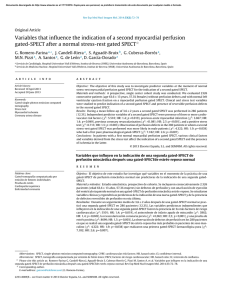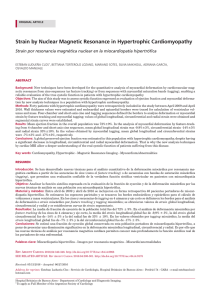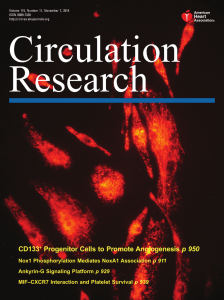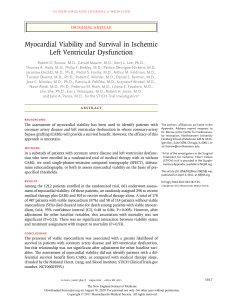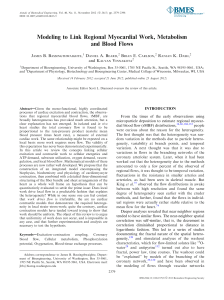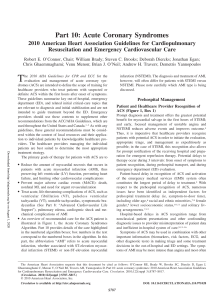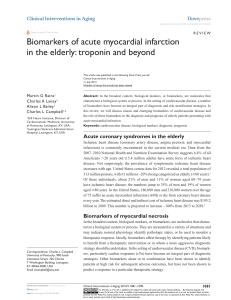Methods for Evaluating Left Ventricular Function Computed
Anuncio
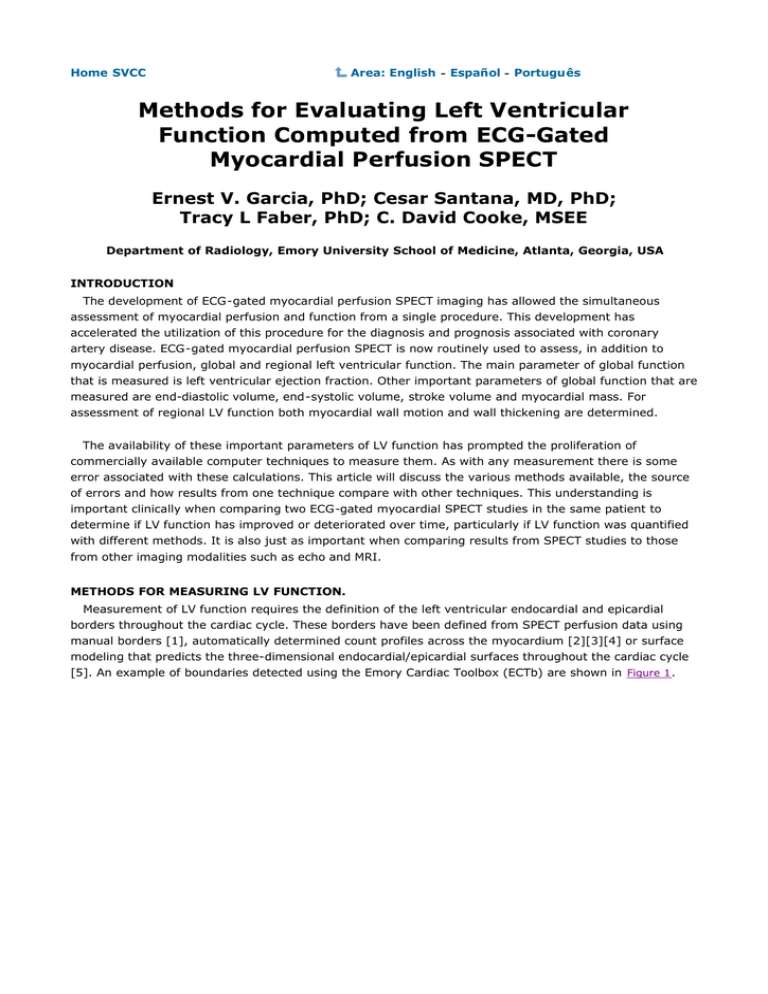
Home SVCC Area: English - Español - Português Methods for Evaluating Left Ventricular Function Computed from ECG-Gated Myocardial Perfusion SPECT Ernest V. Garcia, PhD; Cesar Santana, MD, PhD; Tracy L Faber, PhD; C. David Cooke, MSEE Department of Radiology, Emory University School of Medicine, Atlanta, Georgia, USA INTRODUCTION The development of ECG-gated myocardial perfusion SPECT imaging has allowed the simultaneous assessment of myocardial perfusion and function from a single procedure. This development has accelerated the utilization of this procedure for the diagnosis and prognosis associated with coronary artery disease. ECG-gated myocardial perfusion SPECT is now routinely used to assess, in addition to myocardial perfusion, global and regional left ventricular function. The main parameter of global function that is measured is left ventricular ejection fraction. Other important parameters of global function that are measured are end-diastolic volume, end-systolic volume, stroke volume and myocardial mass. For assessment of regional LV function both myocardial wall motion and wall thickening are determined. The availability of these important parameters of LV function has prompted the proliferation of commercially available computer techniques to measure them. As with any measurement there is some error associated with these calculations. This article will discuss the various methods available, the source of errors and how results from one technique compare with other techniques. This understanding is important clinically when comparing two ECG-gated myocardial SPECT studies in the same patient to determine if LV function has improved or deteriorated over time, particularly if LV function was quantified with different methods. It is also just as important when comparing results from SPECT studies to those from other imaging modalities such as echo and MRI. METHODS FOR MEASURING LV FUNCTION. Measurement of LV function requires the definition of the left ventricular endocardial and epicardial borders throughout the cardiac cycle. These borders have been defined from SPECT perfusion data using manual borders [1], automatically determined count profiles across the myocardium [2][3][4] or surface modeling that predicts the three-dimensional endocardial/epicardial surfaces throughout the cardiac cycle [5]. An example of boundaries detected using the Emory Cardiac Toolbox (ECTb) are shown in Figure 1 . Figure 1. Boundaries at end diastole (top row) and end systole (bottom row) detected from a gated sestamibi cardiac study by the Emory Cardiac Toolbox. From left to right in each row are shown an apical short axis, a mid-ventricular short axis, a vertical long axis, and a horizontal long axis section. Global Function From these surfaces LV volumes are determined in terms of the total number of voxels (volume elements) inside the surface. From this calculation the largest cavity volume throughout the cardiac cycle is defined as the end-diastolic volume (EDV), the smallest cavity volume as the end-systolic volume (ESV) and left ventricular ejection fraction is calculated as the stroke volume (EDV-ESV) divided by EDV. An example of these results as displayed by ECTb is shown in Figure 2. Figure 2. Example of Time/Volume curve computed by the Emory Cardiac Toolbox. LV volumes are graphed versus frame number, and global functional variables are shown on the right. Regional Function From these endocardial/epicardial surfaces regional function is also quantitatively determined as either wall motion or wall thickening. Quantification of regional function is usually determined as the relative movement of one surface or one region of a surface to another. Regional wall thickening is a more clinically relevant parameter to measure since it is more directly indicative of myocardial contraction and viability. Regional wall motion occurs as an outcome of myocardial thickening and is an indirect measurement of LV function and viability. A small necrotic myocardial region can appear to move if the nearby contracting walls are dragging it. It has been shown that, due to partial volume effects, the change in thickening of a myocardial segment is proportional to the change in the maximum count in that segment [6]. Thus, wall thickening may be assessed visually by looking for changes in brightness (or preferably color) of each myocardial segment throughout the cardiac cycle. Wall thickening as calculated by ECTb and displayed in polar map form is shown in Figure 3. Figure 3. Polar plot of regional myocardial thickening displayed by the Emory Cardiac Toolbox. This patient's myocardial thickening was greater than 10% in every region of the LV. The partial volume effect is a phenomenon based totally on physics [7]. Simply stated any object that has a dimension that is less that twice the spatial resolution of an imaging system will exhibit reduced counts in the direction of that dimension in proportion to change in length. Since a myocardial wall is usually smaller than twice the resolution of a system in only one dimension it exhibits a linear proportion between a change in counts and the change in thickness. On the other hand, when comparing a small spherical tumor to a larger spherical tumor the difference in the maximum counts from both will be a cubic relationship since three dimensions are changing at once. The partial volume effect is the basic principle behind the use of the surface modeling method [5] used by ECTb. This approach uses the change in counts throughout the cardiac cycle to determine the change in thickness. This approach uses the myocardial location of the maximal count (corrected for scatter) to determine the midpoint of the myocardial wall segment. The assumption is made that at end-diastole the LV myocardial thickness is 1 cm thick, i.e. 5 mm on either side of the midpoint. This defines both the three-dimensional endocardial and epicardial surfaces. It then uses the regional change in counts from the end-diastolic frame to determine the change in wall thickness and thus, endocardial/epicardial surface locations. For example if at end-systole the myocardial counts in a segment double, the thickness will also double from 1 to 2 cm. This modeling approach is shown graphically in Figure 4. Figure 4. Demonstration of modeling technique used to define LV boundaries by the Emory Cardiac Toolbox. At end diastole, myocardial wall thickness is assumed to be uniformly 10mm thick (t1). Percent thickening, determined by Fourier analysis, is used with the baseline value of 10mm at end diastole to predict myocardial thickness at every additional frame in the cardiac cycle. For every frame, half of the myocardial thickness is added to the myocardial center points to create epicardial surface points; half is subtracted to create endocardial center points. One important aspect of this approach is that is was designed to provide adequate temporal sampling using 8 frames per cardiac cycle [8]. This was done by using Fourier analysis of the phase and amplitude of the maximal count variation in each 3-d myocardial segment. Thus, if conventional temporal sampling is used, 8 frames are not enough to define accurately either global or regional end-diastole or end-systole. The Fourier analysis approach replaces this discrete curve by a continuous curve on a point by point basis to provide a much higher temporal resolution. This is shown graphically in Figure 5. Figure 5. Fourier analysis of count changes to determine thickening during the cardiac cycle. For each myocardial sample, the time/activity curve is fit to a cosine function. The amplitude of the cosine function is used to estimate maximum thickening of the myocardium at that point; the phase of the function is used to estimate phase of the contraction at that point. ACCURACY OF FUNCTIONAL MEASUREMENTS. The accuracy of how well each method determines global and regional parameters of LV function depends on a number of variables. The main variables are the accuracy of the following: the definition of the endocardial and epicardial 3-D surfaces, the valve plane, and the temporal, spatial and contrast resolution. These main variables are also affected by a number of acquisition, processing and patient dependent variables. Acquisition variables that affect the accuracy of functional measurements are the following: 1) the heart rate variability (due to arrhythmia's tachycardia, etc), particularly for different detector positions, 1) count density per frame 2) number of frames per cardiac cycle (8 for Fourier based methods at least 16 for others), 3) radius of orbit (the farther away from the heart the lower the spatial and contrast resolution), 4) appropriate acquisition protocol (collimator, dose, image matrix, number of angles, etc) and 5) standard SPECT problems such as incorrect center of rotation. Processing variables that affect the accuracy of the functional measurements are the following: 1) appropriate reconstruction algorithm and filtering, 2) appropriate definition of oblique angles of the LV, 3) definition of the endocardial and epicardial surfaces, 4) definition of severely hypoperfused walls, 5) definition of the valve plane, 6) degree of automation and 7) ease with which automatically selected parameters are manually overridden when incorrect. Patient dependent variables that affect the accuracy of functional measurements are the following: 1) the heart rate variability (due to arrhythmia's tachycardia, etc), particularly for different detector positions, 2) small left ventricles (< 20 cc ESV), 3) severely hypoperfused myocardium and 4) other standard SPECT problems such as patient motion and high extra-cardiac uptake close to the LV. It is important to understand how specific problems affect the measurements of LV function. For example, low temporal resolution as it occurs when not using enough frames per cardiac cycle tends to affect the calculation by underestimating EDV and overestimating ESV resulting in underestimated LVEF. Small ventricles result in scattered counts from the myocardial walls falling in the LV cavity making it look smaller. Since end-systole is always smaller than end-diastole the end-systole frame is more affected thus making it much smaller than it should be. This leads to a significant overestimation of LVEF, usually in small women. Meaning of accuracy It is also important to understand the meaning of accuracy and how it is misinterpreted. There is a misconception that if a new method correlates highly to a gold standard then it must be accurate. This belief is not necessarily correct. For example, a computer program could be written to aid in the exchange of large monetary bills for smaller one. Suppose that there was a defect in the program in that it would always return exactly 50% of the worth of the large bill. If the two amounts are correlated (worth of large bill vs. total worth of smaller bills) this would result in a perfect correlation (r = 1.00) with a standard error of the estimate of 0. But in fact it would not be accurate since we would all object that we are getting half the amount we expect. The definition of accuracy is hitting the mark, either in getting back the correct amount, or calculating the correct LVEF, EDV and ESV. This only happens if the slope of the line of regression is equal to 1.00 or if the offset from a Bland-Altman analysis is equal to zero. See Figure 6 for a pictorial representation of these concepts. Figure 6. Pictorial demonstration of the difference between accuracy and reproducibility of results. COMPARISON BETWEEN QGS AND ECTB. QGS, or quantitative gated SPECT, is a program developed at Cedars Sinai Medical Center in Los Angeles. Because it was the first program to automatically determine the parameters of LV function from ECG-gated SPECT it became quite popular. The purpose of this section is to compare the results from QGS [2][3] to those of the Emory Cardiac Toolbox (ECTb) [5][8] to demonstrate how physicians need to be careful when comparing results from different commercial systems. Comparison of QGS and ECTb with MR in patients with disease These two methods of computing LV volumes and LVEF from 8-frame gated perfusion single photon emission computed tomograms (SPECT) were compared with each other and with magnetic resonance (MR) [9]. In this investigation thirty-five subjects with coronary artery disease underwent 8-frame gated dual-isotope SPECT imaging and 12-16 frame gated MR. Endocardial boundaries on short axis MR were hand-traced by experts blinded to any SPECT results. MR volumes and EF were computed using Simpson's rule. QGS showed a slight trend towards higher correlation for EFs (r= .72, SEE =0.08 ) than ECTb (r = 0.70, SEE = 0.09), as seen in Figure 7. However, from the Bland-Altman plots, ( Figures 8 and 9), it can be seen that the average difference between MR and SPECT EFs was 0.008 for ECTb, and 0.08 for QGS. For both SPECT methods, LV volumes correlated similarly with MR; although, SPECT volumes were higher than MR values by ~30%. From this study we concluded that QGS and ECTb values of cardiac function computed from 8-frame gated perfusion SPECT correlate very well with each other and well with MR. Averaged over all subjects, ECTb measurements of EF are not significantly different from MR, but QGS significantly underestimates the MR values. Figure 7. Comparison between ejection fractions computed from MR and from gated SPECT using QGS and ECTb. QGS correlates with MR as y=0.77x+0.042; r=.85,SEE=0.06, n=30. ECTb correlates with MR as y=0.82x+0.093; r=.81, SEE=.07, n=30. Figure 8. Bland-Altman plot comparing differences in EFs computed from MR and ECTb. The mean and standard deviation of the difference is -0.008 + 0.075; the regression equation shown is y=0.0043 - 0.01; r=0.006; Figure 9. Bland-Altman plot comparing differences in EFs computed from MR and QGS. The mean and standard deviation of the difference is 0.084 + .066; the regression equation shown is y=0.1x - 0.03; r=.17. Comparison of QGS and ECTb in patients with low likelihood of disease, comparison of normal limits The normal values for LVEF, EDV and ESV have been compared for these two methods to determine the normal limits for each approach [10]. Fifty patients (52 ± 10 years old, 46% female) with less than 5% probability of coronary artery disease, and a dual isotope myocardial perfusion SPECT study (rest thallium and stress gated Tc-99m-sestamibi) were retrospectively selected. All patients underwent exercise stress on treadmill and reached greater than 85% of predicted maximal heart rate. EF and ventricular volumes were obtained completely automatically in all patients using both methods. All studies were successfully processed automatically with both methods. A good correlation was found between both methods for the measurement of LVEF, EDV, and ESV using completely automatic processing (Figures 10-11-12). Nevertheless, the mean of each of these parameters was significantly lower with QGS compared to ECTb. The mean normal EDV as determined by ECTb was 105 ± 33 cc and for QGS was 83 ± 27 cc. The mean normal ESV as determined by ECTb was 36 ± 17 cc and for QGS was 33 ± 16 cc. Finally, the mean LVEF as determined by ECTb was 67% ± 8% and for QGS was 62% ± 9%. Using the mean minus two standard deviations as the lower limit of normal results in a lower limit of normal LVEF for ECTb = 51% and for QGS = 44%. Figure 10. QGS versus ECTb ejection fraction for 50 normal patients. QGS EFs correlated to ECTb EFs as y=0.97x-0.023; r=.87 Figure 11. QGS versus ECTb ED volumes for 50 normal patients. QGS ED volumes correlated to ECTb ED volumes as y=0.71x+8.44ml; r=.89. Figure 12. QGS versus ECTb ES volumes for 50 normal patients. QGS ES volumes correlated to ECTb ES volumes as y=0.88x+1.55ml; r=.92. CONCLUSION ECG-gated myocardial perfusion SPECT has allowed the simultaneous assessment of myocardial perfusion and function, particularly for the left ventricular myocardium. This progress has allowed the assessment of both global and regional left ventricular function. As with any technique, it is important to understand the accuracy of the approach, the variables that determine this accuracy, and the causes of errors. Many different commercial approaches have been implemented. Diagnosticians should be aware of differences when comparing results from different studies in the same patient processed with these different techniques. REFERENCES 1. DePuey EG, Nichols K, Dobrinsky C. Left Ventricular Ejection Fraction Assessed from Gated Technetium-99mSestamibi SPECT. J Nucl Med 1993; 34:1871-1876 2. Germano G, Kiat H, Kavanagh PB, et al. Automatic quantification of ejection fraction from gated myocardial perfusion SPECT. J Nucl Med 1995;36:2138-2147. 3. Germano G, Kavanaugh PB, Berman DS. An automatic approach to the analysis, quantitation and review of perfusion and function from myocardial perfusion SPECT images. International Journal of Cardiac Imaging. 1994;13:337-346. 4. Nichols K, Lefkowitz D, Faber T, Folks R, Cooke D, Garcia EV, Yao SS, DePuey EG, Rozanski A: Echocardiograhic Validation of Gated SPECT Ventricular Function Measurements. J Nucl Med 2000; 41:13081314. 5. Faber TL, Cooke CD, Folks RD, Vansant JP, Nichols KJ, DePuey EG, Pettigrew RI, Garcia EV: Left Ventricular Function and Perfusion from Gated SPECT Perfusion Images: An Integrated Method. J Nucl Med 1999; 40:650659. 6. Galt JR, Garcia EV, Robbins W: Effects of Myocardial Wall Thickness on SPECT Quantification. IEEE Trans. Med. Imaging 1990, 9(2):144-150. 7. Hoffman EJ, Huang SC, Phelps ME: Quantitation in positron emission computed tomography: 1. Effect of object size. Comput Assist Tomogr 1979, 3:299-308. 8. Cooke CD, Garcia EV, Cullom SJ, Faber TL, Pettigrew RI: Determining the Accuracy of Calculating Systolic Wall Thickening Using a Fast Fourier Transform Approximation: A Simulation Study Based on Canine and Patient Data. J Nucl Med 1994; 35:1185-1192. 9. Faber TL, Vansant JP, Pettigrew RI, Galt JR, Blais M, Chatzimavroudis G, Cooke CD, Folks RD, Waldrop SM, Gurtler -Krawczynska E, Wittry MD, Garcia EV: Evaluation of Left Ventricular Endocardial Volumes and Ejection Fractions Computed from Gated Perfusion SPECT with MR: Comparison of Two Methods. J Nucl Cardiol 2001, In Press. 10. Santana CA, Garcia EV, Folks R, Krawczynska EG, Cooke CD, Faber TL: Comparison of Left Ventricular Function Between Two Programs: QGS and Emory Cardiac Toolbox (ECTb). J Nucl Med 2001, 42:166P (Abstract). Top Your questions, contributions and commentaries will be answered by the lecturer or experts on the subject in the Nuclear Cardiology list. Please fill in the form (in Spanish, Portuguese or English) and press the "Send" button. Question, contribution or commentary: Name and Surname: Country: Argentina E-Mail address: @ Send Erase Top 2nd Virtual Congress of Cardiology Dr. Florencio Garófalo Dr. Raúl Bretal Dr. Armando Pacher Steering Committee President Scientific Committee President Technical Committee - CETIFAC President [email protected] [email protected] [email protected] [email protected] [email protected] [email protected] Copyright© 1999-2001 Argentine Federation of Cardiology All rights reserved This company contributed to the Congress
